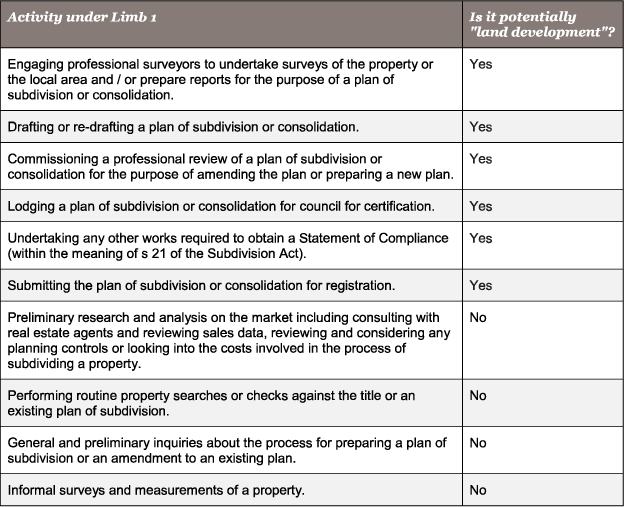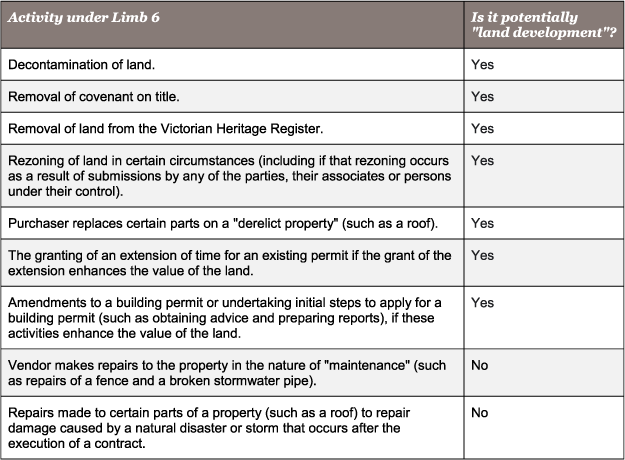
Considering a "sub-sale" in Victoria? New guidance released on what constitutes "land development"

Since their inception, the "sub-sale" provisions in the Victorian stamp duty legislation have become a "double duty" trap for unwary developers, purchasers and investors. In a well-intentioned move, the State Revenue Office of Victoria has issued guidelines in the form of Ruling DA-064 on the meaning of "land development" in the context of the specific "sub-sale" provisions. Developers, purchasers and investors should now be getting new stamp duty advice which reflects this.
The "sub-sale" provisions and the double duty trap: a refresher
The "sub-sale" provisions are contained in Part 4A of Chapter 2 of the Duties Act 2000 (Vic).
In very broad terms, in the context of "land development", the "sub-sale" provisions in the Victorian stamp duty legislation can apply if:
- land is transferred to an entity other than the named purchaser in a sale contract (or the named grantee of an option); and
- certain "land development" takes place in the period between the signing of a sale contract (or grant of an option) and the transfer of the land.
While the "sub-sale" provisions can also be enlivened where there is the provision of certain "additional consideration", this is not covered as part of this article given it relates to separate provisions under the "sub-sale" provisions.
Part of the issue is driven by the inherent complexity of the "sub-sale" provisions and the broad definition of "land development" for the purposes of the "sub-sale" provisions which extends beyond the ordinary meaning of the term (to include, for example, preparing a plan of subdivision or applying for certain permits or approval etc.).
For illustrative purposes, this is one of the more common scenarios where the "sub-sale" provisions can be enlivened in the context of "land development":
- a vendor enters into a sale contract to transfer property to another person (First Purchaser);
- a "Subsequent Purchaser" (which generally speaking, is a person other than the First Purchaser) obtains the right (Transfer Right) to have the property or any part of it transferred, on completion of the sale contract, to the Subsequent Purchaser (Subsequent Transaction);
- after the sale contract is entered into, but before the property or any part of it is transferred, "land development" occurs in relation to the property or part; and
- the vendor transfers the property, or part of it to the "Subsequent Purchaser", who is not the First Purchaser.
Consequently, subject to certain limited exceptions, if "land development" takes place between the contract date and the date the land is transferred to the Subsequent Purchaser, then two lots of duty can potentially be charged – firstly on the sale contract (ie. as if it had been completed by the First Purchaser) and secondly on the Subsequent Transaction. There can also be other lots of duty depending on if there are multiple nominations and / or "Subsequent Purchasers" etc. For illustrative purposes, one of the limited exceptions (and also one of the most important) is if the "land development" occurred after the "Subsequent Purchaser" obtained a "Transfer Right".
What is land development under the new Guidelines?
For the purposes of the "sub-sale" provisions, "land development" has a very broad definition which extends beyond what is generally considered land development under its ordinary meaning. This is one of the key reasons that the "sub-sale" provisions have been a 'double duty' trap since their inception.
While the ordinary meaning of "land development" might suggest an activity involving a change to the physical condition of the land (such as physically pouring concrete on the ground etc.), for the purposes of the "sub-sale" provisions, "land development" can comprise activities which do not involve, or take place prior to, any physical development activities being commenced on the land.
It will comprise any one or more the following six Limbs:
- preparing a plan of subdivision of land or taking any steps to have a plan registered under the Subdivision Act 1988 (Vic);
- applying for or obtaining a permit under the Planning and Environment Act 1987 (Vic);
- requesting a planning authority to prepare an amendment to a planning scheme that would affect the land;
- applying for or obtaining a permit or approval under the Building Act 1993 (Vic);
- doing anything in relation to the land for which such a permit or approval is required; and / or
- developing or changing the land in any other way that would lead to the enhancement of its value.
Importantly, under the Guidelines Limbs 1 to 5 can comprise "land development" regardless of whether the corresponding activities undertaken actually lead to an increase in value or change in utility of the land.
In determining whether an activity constitutes "land development" under the six limbs, the Commissioner will consider:
- the facts, circumstances and context of each activity;
- the "tangible and intentional actions" associated with developing and changing the use of land; and
- the overall effect and consequence of the activity.
Further, the Commissioner's scrutiny of activities that are directly or indirectly undertaken will not be limited only to the conduct of the parties to any sale contract / agreement / nomination. It will also extend to relevant activities directly or indirectly undertaken by related parties, agents, associates and tenants of the parties. This is an important point because it emphasises the responsibility that is placed on certain transaction parties (ie. First Purchasers and Subsequent Purchasers) for the purposes of any potential enlivenment of the "sub-sale" provisions to ensure that they are aware of all activities which are proposed to be undertaken, or which are being undertaken, in respect of the land, even if such activities are not being undertaken by them.
The Guidelines provide commentary (and examples) for each Limb, but we will focus on Limbs 1 and 6 below as they have caused particular confusion.
Limb 1 – Preparing a plan of subdivision or taking any steps to have a plan registered
Undertaking subdivision, consolidation and other plan registration activities are often key aspects of any development of land.
In broad terms, the table below sets out the activities described in the Guidelines and which the Commissioner considers potentially falls or does not fall within the scope of Limb 1.
Importantly, the Commissioner's view is that initial activities undertaken to prepare a plan or measures taken to have a plan registered can constitute "land development". However, in practice, it may be difficult to determine whether an activity or a measure is merely "preliminary" (and therefore not "land development") or whether it constitutes "land development" for the purposes of Limb 1. Accordingly, we recommend that care be taken when engaging or instructing surveyors and internal and external consultants (including when defining the scope of the engagement and instructions).

Limb 6 – Developing / changing land in any other way that would lead to enhancement of its value
Based on the Guidelines, the Commissioner considers that Limb 6 is a quasi catch-all limb for all activities outside of Limbs 1 to 5 if those activities enhance the value of the land.
Practically therefore, the precise scope of Limb 6 is very broad and uncertain, and it is important for entities (ie. First Purchasers and Subsequent Purchasers) to be mindful that even if a specific activity does not fall within Limbs 1 to 5, it could still be determined by the Commissioner to fall into Limb 6 if considered to enhance the value of the land. For example, it is not clear, based on the Guidelines, if any leasing activities (such as entering into an agreement for lease with a tenant) could fall within the scope of Limb 6.
In broad terms, the table below sets out the activities described in the Guidelines and which the Commissioner considers potentially falls or does not fall within the scope of Limb 6.

Furthermore we note the following from the Guidelines:
- if activities are undertaken to enhance the value of land the Commissioner considers it irrelevant whether there are any other contemporaneous activities that may have a negative impact on the land value;
- while the Commissioner will rely on the opinion of the Valuer-General or another competent valuer to determine if the value of land has been enhanced, it is not clear from the Guidelines how evidence in relation to land value put forward by the parties to the agreement will be treated; and
- the Guidelines indicate that the Commissioner will distinguish between repairs that simply preserve the value of land and repairs that enhance the value of land. However, in practice, this can often be difficult to distinguish and therefore we anticipate that this will be an area which will continue to cause confusion for parties when considering whether certain actions fall within Limb 6.
Our take
The Guidelines are not binding on the Commissioner and are not exhaustive. Instead, they demonstrate the Commissioner's approach when determining whether "land development" has occurred for relevant purposes, and they illustrate the broad discretionary powers that the Commissioner has in this regard.
Although in some respects the Guidelines provide much needed clarification, there is still uncertainty for the parties. Given these matters and the complexity of the sub-sale provisions, it is possible that:
- some time could pass after a lodgement has been made before the Commissioner forms a view on whether the transactions trigger the application of the "sub-sale" provisions; and
- parties will potentially have to fund additional stamp duty at short notice if the Commissioner takes the view that there has been "land development" triggering the application of the sub-sale provisions, which may not have been considered or factored in by the parties.
Land developers, purchasers and investors will need to familiarise themselves with the Guidelines and ensure that they engage in a robust process of considering the following questions (ideally before entering into a sale contract or option):
- Is there any prospect of a Subsequent Purchaser obtaining a Transfer Right after exchange (including by novation, assignment or nomination, including any nomination of a related party to accommodate a particular land holding structure)?
- Have any activities been undertaken prior to exchange which could give rise to "land development" occurring after exchange (e.g. whether an application for a planning permit has been made before exchange, with the possibility for the planning permit to be granted after exchange)?
- What activities are proposed to be carried out after exchange by the parties (and by their related parties, agents, associates and tenants)?
- Could any of those activities constitute "land development"? If so, are there any steps that can be taken to manage the risk of an activity being "land development"?
- What is the proposed timing of those activities relative to the timing of any Subsequent Transaction (so as to ensure that any "land development" does not occur between exchange and the date of any Subsequent Transaction)?
Given the complexity of the "sub-sale" provisions and the potentially significant consequences of falling into the "double duty" trap, land developers, purchasers and investors should seek specialised stamp duty advice, particularly before entering into a sale contract or option and prior to undertaking any activity which could potentially comprise "land development" or could otherwise trigger any enlivening of the "sub-sale" provisions.
